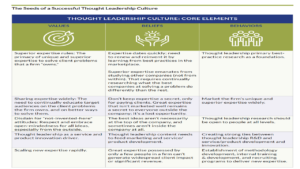B2B companies of seemingly every stripe want to be seen as “thought leaders” these days. They’re putting senior talent in place to achieve it at such companies as talent sourcing provider RGP, staffing giant Manpower, mutual fund king Fidelity Investments, data provider Thomson Reuters, and music streamer Spotify. Their goals may sound arrogant, even ominous (with suggestions of Orwellian mind control). But they’re not. They merely want their audiences (especially customers) to view them as premier experts in their product or service categories. In increasingly complex markets, companies that turn chaos into coherency stand out.
The majority of the 163 firms we surveyed last year told us that being seen as a thought leader was highly or extremely important to selling their offerings. These companies included consulting, IT services, enterprise software, venture capital, private equity, investment banking, and cloud computing firms. They have good reasons for showing off their unique expertise: three-quarters of their customers said thought leadership plays a vital role in deciding whether to use them.
However, just like the old warning we told our kids when they were young (and our parents told us) – “Your eyes are bigger than your stomach” – an organizational desire to be regarded as thought leaders can exceed the will to achieve it. Hearing stories of how a consulting firm built a billion-dollar service on the back of a bestselling book or how a major research study led to a multibillion-dollar new service offering will whet their appetites. But after a few months or a year into seeing how hard it is to develop a novel concept, collect the evidence to prove it works, and launch marketing campaigns that generate interest, many of these firms will give up or scale back.
Over the years, I have worked with many companies to help them get recognition and serious revenue as thought leaders in their domains. But far more often, I’ve seen the desire wane before their thought leadership programs had a monetary impact. They gave up too quickly.
The No. 1 reason is that they don’t fully realize what it takes to play the long game of thought leadership. And don’t kid yourself; thought leadership is a long game. Specifically, most companies that desire to be seen as thought leaders don’t understand precisely what organizational values, beliefs, and behaviors will encourage their people to bring groundbreaking expertise to the market. They act as if merely exhorting their people – Get out there and be thought leaders! – would get it done. If it were only that easy!
If it were, every business book would be published by a prestigious publisher and sell hundreds of thousands of copies. Every wannabee TED TALK speaker would be invited to the big stage in Vancouver, BC. Harvard Business Review’s article acceptance rate would be 99% rather than 1%, and the New York Times would run every op-ed submission. (They reject the vast majority).
Recognizing the premier expert in a business domain means being regarded as the go-to firm with a premium price tag attached. But being seen as the thought leader is also difficult. And it is made only more so in companies that don’t nurture their experts and their experts’ helpers: editors, ghostwriters, speaker coaches, PR professionals, graphic artists, and others with the skills to put the experts in the limelight. Without a nurturing environment, imploring your company’s experts to be seen as thought leaders is like planting palm trees in New England soil. They won’t survive the first winter.
To continue the arboreal analogy, companies that want to compete on thought leadership need a “soil” whose nutrients nurture great ideas from studying best practices, expertise delivered by multiple people, and marketing that educates rather than boasts. This is the soil – the culture – in which thought leadership can flourish continually.
This is where HR comes in. Since they are in charge of people issues, HR executives can play an outsized role in shaping a culture of thought leadership. When a CEO tells the chief marketing officer, “Our firm needs to be seen as thought leaders,” what the CEO and CMO are also unwittingly signing up for is culture tweaking or possibly more.
What kind of culture adjustments am I talking about? Specific values, beliefs, and behaviors are crucial to sustaining thought leadership programs over time. (See Exhibit 1.)

Exhibit 1.
I won’t go through all the cells but will highlight those especially important. These are the organizational values, beliefs, and behaviors on which thought leadership thrives:
- Possessing superior expertise is the ultimate competitive advantage, and it comes from comparing the practices of companies that are best at solving the topic at hand with those that are the worst at it. Companies possessing these values and beliefs fund case study research, which is the wellspring of big ideas.
- They must share superior expertise widely rather than cloaking it in secrecy, available only to those who pay for it. The firms with highly supportive cultures for thought leadership are also prolific publishers of articles and books, experienced conference speakers and organizers, and often-cited social media influencers. They trumpet their expertise widely, knowing it will open doors in high places.
- They scale their expertise rapidly and at high quality rather than quarantine it in the heads of a few thought leaders. Whether in law, consulting, architecture, IT services, training, investment banking, or other firms, they know clients will pay extra for thought leaders who work on their issues. If they can’t get the authors of a bestselling book on their project, they know the project team from that firm is just as capable.
No one is better equipped than the CHRO to help their organization establish the values, beliefs, and behaviors essential to creating a culture of thought leadership. The place for the CHRO to begin is sitting down with the CEO, CMO, head of sales, head of product/service development, research, and other internal experts and discussing what thought leadership means and why it’s essential. That conversation should then quickly move to what the CMO must do, what an internal content development function must do (the place that conducts the best-practice research), and what others must do in their roles to position the firm as the leading expert in its markets for the foreseeable future:
- How will thought-leading content be developed?
- How will it be marketed?
- How will salespeople be equipped to sell like experts?
- And how about the people who deliver the expertise to clients? What programs must be in place to train and develop them so they can deliver an organization’s unique expertise just as competently as its most proficient experts?
Once these thought leadership collaborators understand the programs and processes of thought leadership – and where they need to be involved – the CHRO should lead the conversation about culture. How will the firm’s values, beliefs, and behaviors be adjusted? What values, beliefs, and behaviors will nurture thought leadership right now? Which ones will erode it – how can the firm change them?
A company that understands how it needs to modify its culture to compete in thought leadership is a company that is more likely to sustain thought leadership. If your organization believes superior expertise is the way to compete in the years ahead, it must begin creating a culture of thought leadership right at the start. Please don’t wait until after you’ve created the programs, hired all the people, and set them in motion.
Over time, the culture I’ve described in this article will keep your firm ahead of competitors that also profess the desire to be thought leaders but which lose their drive after the first cold snap of a lackluster book, off-target study, or lightly applauded company-hosted conference. Creating a culture of thought leadership is the ultimate advantage in markets where customers choose firms with the best expertise. CHROs now have the opportunity to be at the center of creating that advantage.



